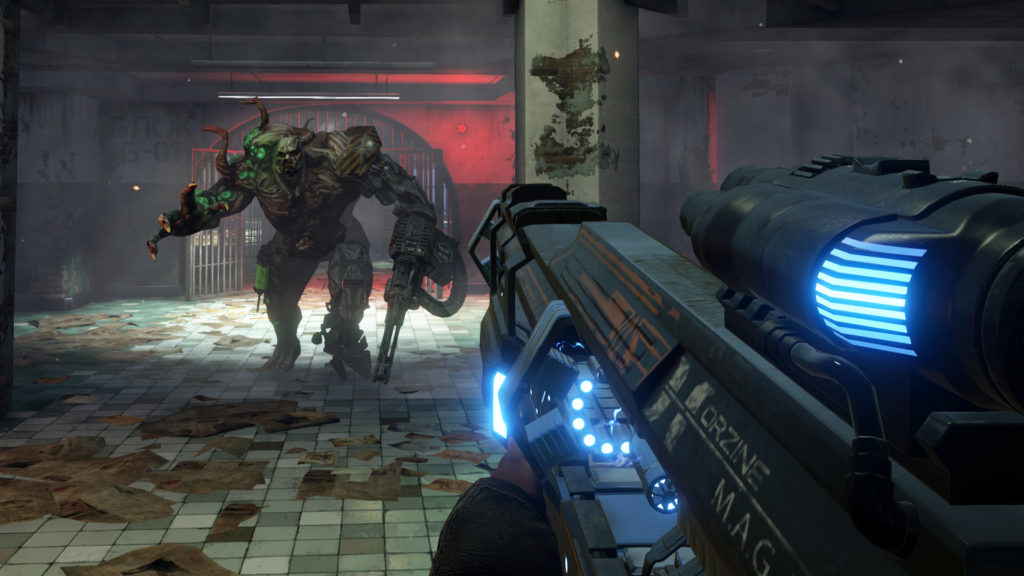In the over-the-top horror game, Killing Floor 2, up to six players are challenged to work cooperatively and combine their firepower to fend off waves of “Zeds” (also referred to as “specimens”)—mutant monsters that are somewhat comparable to zombies. They come crawling, staggering and running out with the single-minded goal of wiping out the players.
The first game released in 2009 exclusively for the PC, and developer Tripwire Interactive maintained the game for several years with annual events and updates, supported by a large community of modders, before announcing a sequel. Killing Floor 2 spent over a year in Steam Early Access before officially launching last November. In addition to featuring spectacularly gory graphics, the sequel has a special versus mode, where teams of six battle against each other—one team as the humans, the other as the Zeds. Furthermore, the game is expanding its audience by releasing for the PlayStation 4 with support for the PlayStation 4 Pro.
Tripwire Interactive vice president, Alan Wilson, recently spoke to [a]listdaily about growing the Killing Floor brand to include a console audience and what it will take to keep the sequel running for at least seven more years.

Did the reputation of the previous game on PC help make promotion on the PlayStation 4 easier?
It is a mixed blessing, to some extent. On the one hand, all those who already know the game and Tripwire as a studio are likely to be very positive and become evangelists for us on a new platform. Happily, we never really got much into the “PC vs. console” debate, as we were able to make clear from early on that neither platform was going to “suffer” in any way to make it easier for us to support multi-platform.
More recently, we had the PS4 Pro support that we could highlight as well, so that the PS4 was getting all the gameplay of the PC version along with controller support designed in from the get-go and 4K support. The reputation of Killing Floor 1 certainly helped, but it was still an entirely new franchise to a significant portion of the console player-base. To that end, we’re back at promoting something completely new, even though to us and the PC fans, it is a sequel to a very successful game. That really just meant we had to manage the messaging subtly and differently between the platforms.
How have players taken to the game?
For PC, it was a sequel to a highly-successful first game, but on the PS4, it is a new franchise, albeit well-known to some players. Mind you, judging by the noise we got at the first PSX in Las Vegas to the game’s announcement in the keynote presentation, I’d say there were already a good few gamers who were really happy to see the franchise come to console!
Have you found that PC and PS4 players have different expectations from the game?
In general, not hugely. There are requests like split-screen for the console, but mostly we’re finding that a game involving 6-player co-op and 6-vs.-6 player competition really migrates very easily between the platforms. In this day and age, the distinctions between the hardware are rapidly blurring, and the gaps closing, so there is less and less reason for games to be very different.
How did a lengthy Early Access period help with promoting the game?
I’d have to say it has sometimes been a mixed bag. Initially in the Early Access period, we were simply overwhelmed by the sheer volume of feedback coming in. It was well above our expectations. That told us that a lot of players were heavily engaged and vested in the game, which is a good thing. But it did leave us scrambling in the early months to handle it all, respond to it, and quickly roll out updates to the game. It took us longer than we wanted to really hit our stride with updates. The flip side, of course, is that the game has been very well honed as a result of all that feedback. So, we did have to deal with some disappointment in the first months, as we struggled to keep up the pace. However, once we’d hit that stride, it meant that we could show dramatic additions and improvements to the game, and that is always well received by players.
What is the key to keeping a game like Killing Floor 2 engaging for the long run?
We learned a lot of lessons with the first game. We were trying out all sorts of ideas over the years—providing extra content to the game for free. This meant our own content (maps, weapons, characters and the much-loved seasonal events), as well as a growing pool of community-made content. So, we added in Steam Workshop support and unlockable items and DLC packs as well. Some of that was effectively retrofitted to the first game.
With Killing Floor 2, we’ve built for that from the get-go. Systems [are there] from the start, allowing for content to be put into the Workshop much more easily, and it’s much easier to find in-game. [We’re] monetizing the best of that content through the in-game economy, so that contributions from the community can be more directly rewarded with actual money, which has led to a wonderful level of support from the community, providing players with a ton of great content. We’ll continue to supplement that by encouraging community mappers, with things like mapping contests and making the best of that material “official,” so that it is seen by everyone.
The seasonal events haven’t been forgotten, naturally, and we’ve got a few more ideas we’ll be trying out as we go. Ultimately, we provided enough new content to Killing Floor 1 to keep the game fresh—and players returning regularly—for over six years. So, we’ll be doing all that and more for hopefully for just as long with Killing Floor 2.
A large feature on the PC side is mod support. How challenging was it to bring KF2 to the PS4 without the support from that community?
The key point is that we’re not going to leave all that support behind. Clearly, yes, we are more limited in what we can do on the PS4, but the PS4 players are already seeing a bunch of content generated by PC modders in the in-game economy, as well as community-made maps included for free with the game itself. That isn’t going to stop. We’ll continue to bring as much of that content as we can across from the PC. Hopefully, console players will soon learn that we provide a lot of support to our games in the form of additional free content and special events. We have always operated that way, and we’re not planning to change that just because we’re operating on new platforms.
Has PlayStation 4 Pro support helped to further popularize the game?
The PS4 Pro certainly enabled us to get an “in” on a surge of interest. Apart from being able to show people how good the game looks by ourselves, it has also gotten us into Sony’s marketing alongside games with very much bigger marketing budgets than we can afford.
What led to partnering with GameStop for the exclusive retail release?
The practicalities of the current retail market, realistically. Shelf-space is much more limited than it was even just a few years ago, especially during the November timeframe, when so many big-budget games are launching. It becomes a serious fight for the buyers’ attention and for the store managers’ inventory slots. On this occasion, Deep Silver (who handled the retail distribution in North America) simply got to a great deal with GameStop, and we went with it. Early indications are that many GameStop stores sold out overnight and have re-ordered, so hopefully everyone will be happy with it!
What do you think it is about Killing Floor 2 that inspires such a dedicated fan base?
That’s the $64-million-dollar question. We see it as a combination. At the core, you have (as many reviewers have been saying) a wave-based horde shooter, honed to be the very best of its breed, with a combination of awesome gunplay, crazy monsters, great level design, mad levels of gore, and some dark humor sprinkled in. Perfect mayhem after a busy day at work or school. But the fans are also dedicated because of the levels of support we’ve always brought to our games, with free content, special events and unlockable content rolling for years. Players do not need any of the content that is available to buy ([premium] DLC in the first game, [and] through the economy in Killing Floor 2) but many players do choose to pay for some of it—both because it is fun and because the revenue it generates also helps pay for the ongoing stream of content that every single player gets for free.

